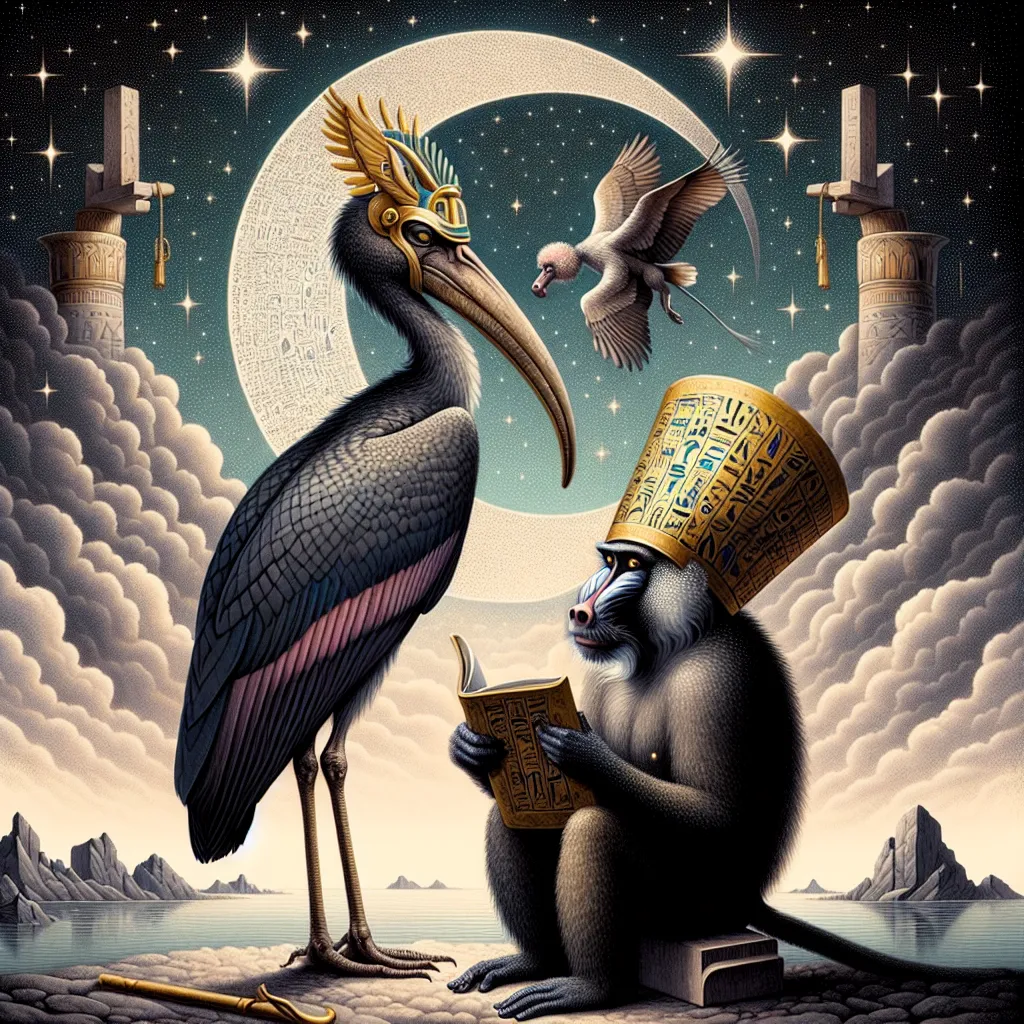
- Published on
- Authors

- Name
- You
The Symbolism of Thoth: Ibis, Baboon, and the Crescent Moon
Thoth, one of the most enigmatic deities of ancient Egyptian mythology, embodies the essence of knowledge, wisdom, and the mystical realms of the unseen. Represented through the forms of an ibis, a baboon, and the crescent moon, each symbol reveals intricate layers of meaning, weaving together a tapestry of magical and scientific insights.
The Ibis: A Symbol of Purity and Wisdom
Ornithological Insights
The ibis, with its delicate and serene appearance, was more than just a bird to the ancients. Scientifically, the Threskiornis aethiopicus, commonly known as the Sacred Ibis, played a crucial role in the ecosystem of the Nile. This wading bird, with its slender, down-curved bill, is adept at probing mudflats for insects, crustaceans, and other small invertebrates.
Mystical Symbolism
In the mysticism of ancient Egypt, the ibis was revered for its purity. Thoth, often depicted with the head of an ibis, symbolized purity of thought and clarity of mind. The bird's behavior, especially its systematic foraging, reflected methodical and ordered thinking—principles that Thoth, the divine scribe, bestowed upon humanity through the invention of writing and the maintenance of the universe's laws.
The Baboon: Keeper of Secrets and Time
Primatological Insights
The baboon, specifically the species Papio hamadryas, played a unique role in Egyptian mythos. Baboons are highly social animals with complex behavioral patterns, exhibiting remarkable intelligence and even a rudimentary sense of time through their daily activities and interactions.
Mystical Symbolism
Thoth as a baboon represents the intellect and the mysterious depths of wisdom. Baboons were often depicted in temple art sitting in judgment at the scales of Ma'at, symbolizing their discerning nature. Their link with Thoth also touches upon the lunar aspect, as baboons are known to howl at sunrise, which the Egyptians interpreted as worship of the sun and its cyclical nature.
The Crescent Moon: A Celestial Emblem
Astronomical Insights
The crescent moon's shape and phases are results of the moon's orbit around the Earth, offering profound insights into celestial mechanics and the passage of time. Modern astronomy has detailed how the moon influences everything from ocean tides to biological rhythms.
Mystical Symbolism
In Thoths symbology, the crescent moon is not merely an astronomical body but a manifestation of the cycles of time, wisdom, and rebirth. The moon's phases echo the cycles of life, death, and regeneration—key elements in Thoth’s role as a deity of wisdom and recorder of time. The crescent, often adorned on Thoths head, acts as a bridge between the cosmic and terrestrial, underscoring his function as a mediator between the heavens and Earth.
Table of Symbols and Their Meanings
| Symbol | Scientific Aspect | Mystical Aspect |
|---|---|---|
| Ibis | Bird species aiding in ecosystem balance | Purity of thought, clarity of mind |
| Baboon | Intelligent primate with social behaviors | Keeper of secrets, intellect, time |
| Crescent Moon | Lunar phases affecting tides and rhythms | Cycles of time, wisdom, rebirth |
Conclusion
The rich symbolism of Thoth—through the ibis, baboon, and crescent moon—reminds us of the seamless blend of scientific understanding and mystical wisdom that ancient cultures embraced. Each symbol enriches our perception of Thoth, offering a multifaceted glimpse into the divine nature of knowledge and the universe's intricate workings. By studying these symbols, we not only honor the past's profound insights but also expand our own understanding of the timeless dance between the seen and unseen worlds.
